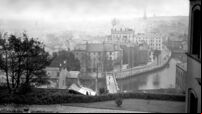Cork ship’s role in the Mary Celeste mystery

The Dei Gratia at Messina, Sicily, in April, 1873, from a painting by Giuseppe Coli. The vessel found the Mary Celeste a year earlier, and ended her life in Cork. She is said to now reside under Haulbowline Island’s piers
Tim Morley’s query last week about a house on the Southside of Cork city where Daniel Corkery lived in later life?


Send us your memories. Email [email protected]. Or leave a comment on our Facebook page: https://www.facebook.com/echolivecork.







